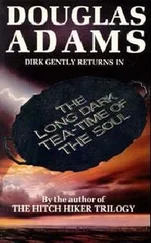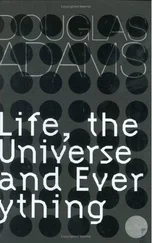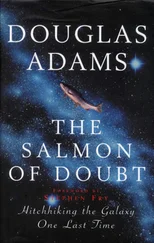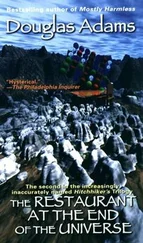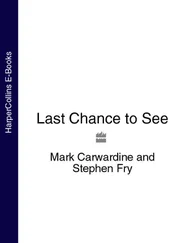Douglas Adams - Last chance to see
Здесь есть возможность читать онлайн «Douglas Adams - Last chance to see» весь текст электронной книги совершенно бесплатно (целиком полную версию без сокращений). В некоторых случаях можно слушать аудио, скачать через торрент в формате fb2 и присутствует краткое содержание. Жанр: Фантастика и фэнтези, на английском языке. Описание произведения, (предисловие) а так же отзывы посетителей доступны на портале библиотеки ЛибКат.
- Название:Last chance to see
- Автор:
- Жанр:
- Год:неизвестен
- ISBN:нет данных
- Рейтинг книги:5 / 5. Голосов: 1
-
Избранное:Добавить в избранное
- Отзывы:
-
Ваша оценка:
- 100
- 1
- 2
- 3
- 4
- 5
Last chance to see: краткое содержание, описание и аннотация
Предлагаем к чтению аннотацию, описание, краткое содержание или предисловие (зависит от того, что написал сам автор книги «Last chance to see»). Если вы не нашли необходимую информацию о книге — напишите в комментариях, мы постараемся отыскать её.
Last chance to see — читать онлайн бесплатно полную книгу (весь текст) целиком
Ниже представлен текст книги, разбитый по страницам. Система сохранения места последней прочитанной страницы, позволяет с удобством читать онлайн бесплатно книгу «Last chance to see», без необходимости каждый раз заново искать на чём Вы остановились. Поставьте закладку, и сможете в любой момент перейти на страницу, на которой закончили чтение.
Интервал:
Закладка:
None of us would admit to having brought the cricket bat. We couldn't understand what it was doing there. We phoned room service to bring us up some beers and also to take the cricket bat away but they didn't want it. The guy from room service said that _if we were really going to look for man-eating lizards maybe the cricket bat would be a handy thing to have.
'If you find you've got a dragon charging towards you at thirty miles an hour snapping its teeth you can always drive it defensively through the covers,' he said, deposited the beers and left:
We hid the cricket bat under the bed, opened the beers, and let Mark explain something of what we were in for.
'For centuries,' he said, 'the Chinese told stories of great scaly man-eating monsters with fiery breath, but they were thought to be nothing more than myths and fanciful imaginings. Old sailors would tell of them, and would write 'Here be dragons' on their maps when they saw a land they didn't at all like the look of.
'And then, at the beginning of this century, a pioneering Dutch aviator was attempting to island hop his way along the Indonesian archipelago to Australia when he had engine trouble and had to crash land his plane on the tiny island of Komodo. He survived the crash but his plane didn't.
'He went to search for water. As he was searching he found a strange wide track on the sandy shore, followed the track, and suddenly found himself confronted with something that he, also, didn't at all like the look of. It appeared to be a great scaly man-eating monster, fully ten feet long. What he was looking at was the thing we are going to look for - the Komodo dragon lizard.'
'Did he survive? I asked, going straight for the point.
'Yes, he did, though his reputation didn't. He stayed alive for three months, and then was rescued. But when he went home, everyone thought he was mad and nobody believed a word of it.'
'So were the Komodo dragons the origin of the Chinese dragon myths?
'Well, nobody really knows, of course. At least, I don't. But it certainly seems like a possibility. It's a large creature with scales, it's a man-eater, and though it doesn't actually breathe fire, it does have the worst breath of any creature known to man. But there's something else you should know about the island as well.'
'What?'
'Have another beer first.'
I did.
There are,' said mark, 'more poisonous snakes per square metre of ground on Komodo than on any equivalent area on earth.'
There is in Melbourne a man who probably knows more about poisonous snakes than anyone else on earth. His name is Dr Struan Sutherland, and he has devoted his entire life to a study of venom.
'And I'm bored with talking about it,' he said when we went along to see him the next morning, laden with tape recorders and note books. 'Can't stand all these poisonous creatures, all these snakes and insects and fish and things. Wretched things, biting everybody. And then people expect me to tell them what to do about it. I'll tell them what to do. Don't get bitten in the first place. That's the answer. I've had enough of telling people all the time. Hydroponics, now, that's interesting. Talk to you all you like about hydroponics. Fascinating stuff, growing plants artificially in water, very interesting technique. We'll need to know all about it if we're going to go to Mars and places. Where did you say you were going?'
'Komodo.'
'Well, don't get bitten, that's all I can say. And don't come running to me if you do because you won't get here in time and anyway I've got enough on my plate. Look at this office. Full of poisonous animals all over the place. See this tank? It's full of fire ants. Venomous little creatures, what are we going to do about them? Anyway, I got some little cakes in in case you were hungry. Would you like some little cakes? I can't remember where I put them. There's some tea but it's not very good. Sit down for heaven's sake.
'So, you're going to Komodo. Well, I don't know why you want to do that, but I suppose you have your reasons. There are fifteen different types of snake on Komodo, and half of them are poisonous. The only potentially deadly ones are the Russell's viper, the bamboo viper and the Indian cobra.
The Indian cobra is the fifteenth deadliest snake in the world, and all the other fourteen are here in Australia. That's why it's so hard for me to find time to get on with my hydroponics, with all these snakes all over the place.
'And spiders. The most poisonous spider is the Sydney funnel web. We get about five hundred people a year bitten by spiders. A lot of them used to die, so we had to develop an antidote to stop people bothering me with it all the time. Took us years. Then we developed this snake bite detector kit. Not that you need a kit to tell you when you've been bitten by a snake, you usually know, but the kit is something that will detect what type you've been bitten by so you can treat it properly.
'Would you like to see a kit? I've got a couple here in the venom fridge. Let's have a look. Ah look, the cakes are in here too. Quick, have one while they're still fresh. Fairy cakes, I baked 'em myself.'
He handed round the snake venom detection kits and his home-baked fairy cakes and retreated back to his desk, where he beamed at us cheerfully from behind his curly beard and bow tie. We admired the kits, which were small, efficient boxes neatly packed with tiny bottles, a pipette, a syringe and a complicated set of instructions that I wouldn't want to read for the first time in a panic, and then we asked him how many of the snakes he had been bitten by himself.
'None of 'em,' he said. 'Another area of expertise I've developed is that of getting other people to handle the dangerous animals. Won't do it myself. Don't want to get bitten, do I? You know what it says in my book jackets? "Hobbies: gardening -with gloves; fishing - with boots; travelling - with care." That's the answer. What else? Well, in addition to the boots wear thick, baggy trousers, and preferably have half a dozen people tramping along in front of you making as much noise as possible. The snakes pick up the vibrations and get out of your way, unless it's a death adder, otherwise known as the deaf adder, which just lies there. People can walk right past it and over it and nothing happens. I've heard of twelve people in a line walking over a death adder and the twelfth person accidentally trod on it and got bitten. Normally you're quite safe if you're twelfth in line. You're not eating your cakes. Come on, get them down you, there's plenty more in the venom fridge.'
We asked, apprehensively, if any of the folk remedies or potions we'd heard about were any good.
`Well, nine times out of ten they'll work fine for the simple reason that nine snake bites out of ten the victim doesn't get ill anyway. It's the last ten per cent that's the problem, and there's a lot of myths we've had to disentangle about snakes in order to get at the truth. You need accurate information. People's immediate response to snake bites is often to overreact and give the poor snake a ritual beating, which doesn't really help in the identification. If you don't know which exact snake it was you can't treat the bite properly.' .
'Well, in that case,' I asked, 'could we perhaps take a snake bite detector kit with us to Komodo?
'Course you can, course you can. Take as many as you like. Won't do you a blind bit of good because they're only for Australian snakes.'
'So what do we do if we get bitten by something deadly, then? I asked.
He blinked at me as if I were stupid.
'Well what do you think you do? he said. 'You die of course. That's what deadly means.'
'But what about cutting open the wound and sucking out the poison? I asked.
'Rather you than me,' he said. 'I wouldn't want a mouthful of poison. Shouldn't do you much harm, though. Snake toxins have a high molecular weight, so they won't penetrate the blood vessels in the mouth the way that alcohol or some drugs do, and then the poison gets destroyed by the acids in your stomach. But it's not necessarily going to do much good, either. You're not likely to be able to get much of the poison out, but you're probably going to make the wound a lot worse trying. And in a place like Komodo it means you'd quickly have a seriously infected wound to contend with as well as a leg full of poison. Septicaemia, gangrene, you name it. It'll kill you.'
Читать дальшеИнтервал:
Закладка:
Похожие книги на «Last chance to see»
Представляем Вашему вниманию похожие книги на «Last chance to see» списком для выбора. Мы отобрали схожую по названию и смыслу литературу в надежде предоставить читателям больше вариантов отыскать новые, интересные, ещё непрочитанные произведения.
Обсуждение, отзывы о книге «Last chance to see» и просто собственные мнения читателей. Оставьте ваши комментарии, напишите, что Вы думаете о произведении, его смысле или главных героях. Укажите что конкретно понравилось, а что нет, и почему Вы так считаете.

